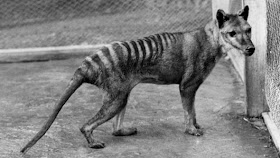Among Tasmanian’s native animals, it seems to be that the least understood is theThylacine (ThylacinusCynosephalus). Also known as the Tasmanian tiger because of its striped back, it is native to Australia, Tasmania and New Guinea. It has been believed that Tasmanian tigers had been already extinct in the 20th century.
Due to its queer look and appearance, one which looks like a large and long dog with a big head coupled withthe body having short soft brown fur with a combination of dark brown-black stripes that extended from the base of the tail to almost the shoulders. It has a heavy stiff tail and a big head, this particular animal has been greatly feared by early European settlers pushing them to kill this species no matter what the cost.
The scientific name, ThylacinusCunocephalus means pouched dog with a wolf’s head which earned its other name, Tasmanian wolf. When fully grown, the Tasmanian tiger can stand as tall as 2 feet, approximately about 58 centimeters and a body length of about 6 feet equivalent to 180 centimeters. Weight varies although it can reach to a maximum of 30 kilograms.
The Tasmanian tiger is generally shy and quiet and does not usually produce a sound. It can sometimes be mistaken as mute. However, when it becomes excited, a husky and seemingly cough-like bark is produced. When a Tasmanian tiger is at the wild while hunting for prey, it usually produces a distinctive terrier-like yap or cry which is done repeatedly at least every few seconds.
At the same time, there had not been recordings and studies made about this enigmatic marsupial carnivore primarily because the Tasmanian tiger is low profile, secretive and easily gets nervous. Some even die struggling because of too much fear and apparently from shock. Despite this weakness, it has a strong and persistent stamina that can withstand exhaustion and can pursue its prey ruthlessly and uncompromisingly.
This mysterious Tasmanian tiger, although threatened and even extinct has a keen sense of smell, primarily relying on this strong sense to search for prey and to survive in the wild. Its diet revolved mainly on wallabies and rabbits, also including animals and some birds. It also hunted down sheep and poultry that belonged to early European settlers causing a revengeful hunt on the side of the farm owners.
Tasmanian Tiger Video


No comments:
Post a Comment